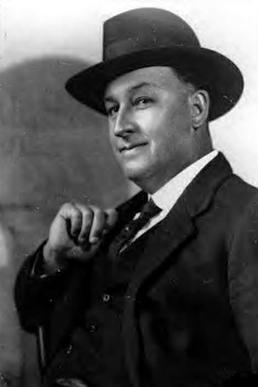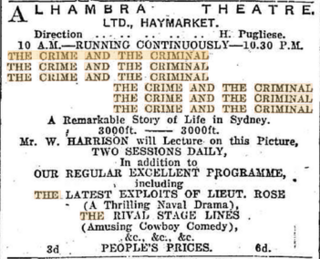
John F. Gavin was a pioneer Australian film actor and director, one of the early filmmakers of the 1910s. He is best known for making films about bushrangers such as Captain Thunderbolt, Captain Moonlite, Ben Hall and Frank Gardiner. Known informally as 'Jack', Gavin worked in collaboration with his wife Agnes, who scripted many of his films.

Raymond Longford was a prolific Australian film director, writer, producer, and actor during the silent era. Longford was a major director of the silent film era of the Australian cinema. He formed a production team with Lottie Lyell. His contributions to Australian cinema with his ongoing collaborations with Lyell, including The Sentimental Bloke (1919) and The Blue Mountains Mystery (1921), prompted the Australian Film Institute's AFI Raymond Longford Award, inaugurated in 1968, to be named in his honour.

The Assigned Servant is a 1911 Australian silent film about a convict who is transported to Van Diemen's Land. It was made by the husband-and-wife team of John and Agnes Gavin and is considered a lost film.

The Romantic Story of Margaret Catchpole, generally referred to as Margaret Catchpole, is a 1911 Australian silent film directed by Raymond Longford and starring Lottie Lyell. It is based on the true story of Margaret Catchpole, an adventurer and convict.

Alfred Rolfe, real name Alfred Roker, was an Australian stage and film director and actor, best known for being the son-in-law of the celebrated actor-manager Alfred Dampier, with whom he appeared frequently on stage, and for his prolific output as a director during Australia's silent era, including Captain Midnight, the Bush King (1911), Captain Starlight, or Gentleman of the Road (1911) and The Hero of the Dardanelles (1915). Only one of his films as director survives today.

Captain Midnight, the Bush King is a 1911 Australian silent Western film about the fictitious bushranger Captain Midnight. It was the directorial debut of actor Alfred Rolfe. The film is based on the play of same name by W. J. Lincoln and Alfred Dampier. Captain Midnight, the Bush King is now considered lost.
Captain Starlight, or Gentleman of the Road is a 1911 Australian silent film about the bushranger Captain Starlight. It was based on Alfred Dampier's stage adaptation of the 1888 novel Robbery Under Arms. It is considered a lost film.
The Life of Rufus Dawes is a 1911 Australian silent film based on Alfred Dampier's stage adaptation of the 1874 novel For the Term of His Natural Life produced by Charles Cozens Spencer.

The Lady Outlaw is a 1911 Australian silent film set in Van Diemen's Land during convict days.
The Cup Winner is a 1911 Australian silent film directed by Alfred Rolfe. It is set against a backdrop of horseracing and the finale involves real footage from the 1911 Melbourne Cup.
Caloola, or The Adventures of a Jackeroo is a 1911 Australian silent film directed by Alfred Rolfe based on a novel published the previous year by Clement Pratt.

The Crime and the Criminal is a 1912 Australian silent film directed by Alfred Rolfe. It features the same railway collision as the climax in Do Men Love Women? (1912) which had come out only a few weeks prior. However the plots of the movies are different.
Won on the Post is a 1912 Australian silent film directed by Alfred Rolfe set against a backdrop of horseracing.

The Loyal Rebel is a 1915 Australian silent film directed by Alfred Rolfe set against the background of the Eureka Rebellion.
The Life of a Jackeroo is a 1912 Australian silent film directed by Franklyn Barrett. It is considered a lost film.

Bushranger's Ransom, or A Ride for Life was an Australian silent film produced by Pathé Frères' in 1911, their first motion picture production in Australia after establishing a branch office in Sydney in April 1910. It was adapted from a stage play first performed in 1907 by E. I. Cole's Bohemian Dramatic Company.

Dan Morgan is a 1911 Australian film from Charles Cozens Spencer about the bushranger Daniel Morgan. It was said to be starring "Alfred Rolfe and company". Rolfe directed three movies for Spencer, all starring himself and his wife Lily Dampier so there is a chance he may have directed this one and that it starred his wife. A prospectus for the Australian Photo Play Company said he directed it. It is considered a lost film.
For Australia is a 1915 Australian silent film directed by Monte Luke.
The Australian Photo-Play Company was a short-lived but highly productive Australian film production company which operated from 1911 to 1912.
A Man – That's All (1916) is an Australian war film directed by Alfred Rolfe for Australasian Films.












